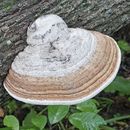Biology
provided by Arkive
Fungi are neither plants nor animals but belong to their own kingdom. They are unable to produce their own food through the process of photosynthesis, as plants do; instead, they acquire nutrients from living or dead plants, animals, or other fungi, as animals do. In many larger fungi (except lichens) the only visible parts are the fruit bodies, which arise from a largely unseen network of threads called 'hyphae'. These hyphae permeate the fungus's food source, which may be soil, leaf litter, rotten wood, dung, and so on, depending on the species, and take up nutrients (3).
The inedible fruit bodies of artist's fungus are found throughout the year (5). They grow alone or in overlapping groups on the trunk of the host tree (3). This parasitic fungus causes a white rot in host timber and eventually kills living trees (3).
Conservation
provided by Arkive
Not relevant.
Description
provided by Arkive
Artist's fungus forms bracket-like fruit bodies that are reddish brown in colour (4). The hard waxy crust has a knobbly surface (3), and the flesh is dark reddish-brown, with a fibrous texture (4). Spores are released from pores located on the underside of the fungus. The pores are initially white, but become brownish as they age (4). This species releases massive amounts of brown spores, which collect on other fruit bodies and on the trunk of the host tree. This often gives the impression that the area has been liberally sprinkled with cocoa powder (3). An unusual form of this fungus occurs fairly frequently, in which layers of whitish flesh occur throughout the fruit body. Patterns scratched into these white layers are permanent, and this practice explains the common name of this species, 'artist's fungus' (3).
WARNING: many species of fungus are poisonous or contain chemicals that can cause sickness. Never pick and eat any species of fungus that you cannot positively recognise or are unsure about. Some species are deadly poisonous and can cause death within a few hours if swallowed.
Habitat
provided by Arkive
Parasitic on a range of living or dead broad-leaved trees, but favours beech (4). In many parts of its range it occurs in mountainous areas (3).
Range
provided by Arkive
This fungus has a wide distribution in Britain but is not common (4). It is also found in Europe and North America as well as Trinidad, Panama, Columbia and Venezuela (3).
Status
provided by Arkive
Widespread in Britain (3).
Threats
provided by Arkive
This species is not threatened at present.

